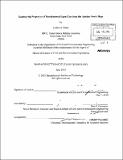Engineering properties of Resedimented Ugnu Clay from the Alaskan North Slope
Author(s)
Jones, Cullen A. (Cullen Albert)
DownloadFull printable version (119.5Mb)
Alternative title
Engineering properties of RUC from the Alaskan North Slope
Other Contributors
Massachusetts Institute of Technology. Dept. of Civil and Environmental Engineering.
Advisor
John T. Germaine.
Terms of use
Metadata
Show full item recordAbstract
This research determined the engineering properties of laboratory Resedimented Ugnu Clay (RUC) specimens created using recovered material from 3800 ft below the surface of the Alaskan Northern Slope to aid with future petroleum exploration. Thirteen constant rate of strain (CRS) tests were performed to ascertain the compression properties as a function of consolidation stress. Consolidation stress for these specimens ranged from 6,800 kPa to 39,000 kPa. CRS results show that the compression ratio (CR) decreases with increasing consolidation stress which is in accord with research completed on resedimented Boston Blue clay (RBBC) and behavior of RUC during Ko consolidation. The CRS data established a value of cv at 0.0015 cm 2/sec and an average Ck of the tested specimens at approximately 0.35. Thirteen K, consolidated triaxial compression tests were performed to ascertain the Ko and undrained shear properties as a function of consolidation stress. Consolidation stress for these specimens ranged from 190 kPa to 9,800 kPa. The range of Ko at maximum stress ranged from 0.47 to 0.65 where increasing consolidation stress resulted in an increase in Ko values and a decrease in undrained shear strength, which is in accord with research completed on resedimented Boston Blue clay (RBBC) and resedimented Gulf of Mexico Clay (RGOM) at MIT. Undrained Strength Ratios (USRs ) ranged from 0.262 to 0.349 with a trend of decreasing normalized strength and strain softening, and increasing axial strain at failure increase with increasing consolidation stress. Peak friction angles during shearing ranged from 20.30 - 27.80 with a general trend of decreasing with increasing consolidation stress. Observed Skempton's A parameters at failure (Af) ranged from 0.407 to 0.777 with a trend of with increasing with consolidation stress. Normalized secant moduli (Eu/o've ) measured at 0.01 % axial strain ranged from 150 to 475 with the trend of decreasing with increasing consolidation stress. When compared with RBBC and RGOM, the effects of plasticity and mineralogy on clay behavior are readily apparent. These results will provide data to perform analysis and design of petroleum exploration strategies and calibrate soil models.
Description
Thesis (S.M.)--Massachusetts Institute of Technology, Dept. of Civil and Environmental Engineering, 2010. Cataloged from PDF version of thesis. Includes bibliographical references (v. 1, p. 248-256).
Date issued
2010Department
Massachusetts Institute of Technology. Department of Civil and Environmental EngineeringPublisher
Massachusetts Institute of Technology
Keywords
Civil and Environmental Engineering.